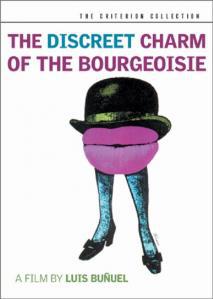Born in Eastern Spain in the year 1900, Buñuel grew up in a wealthy family, but always had a contemptuous and rebellious attitude. When he was 25, he moved to Paris where he worked briefly as a secretary, and then as an assistant to director Jean Epstein. Not long after, he developed a serious interest in film and worked with assistance from family and his good friend Salvador Dali on the surrealist short
Un Chien Andalou, which at the time was regarded with confusion, but is now thought of by many to be the greatest short film of all time. It consisted of little more than a series of disturbing, surreal images that seem to tell the story of a woman being pursued by a man who develops an unhealthy sexual fixation on her. It contained such controversial images as a woman’s eyeball being sliced by a razor, that Buñuel was concerned would cause people to react violently. At the film’s premiere, he famously sat in the back with a bucket of stones to throw at audience members if they became hostile.
His next film, L’Age D’Or, was another collaboration with Dali, but the two had an argument before shooting began and Dali eventually had nothing to do with the film. The movie, which had a similar nature and style to its predecessor, caused outrage and scandal. It was banned for 50 years. After this, he returned to Spain and worked on a short documentary, Land Without Bread, which told of Las Hurdes, a Spanish slum full of vagrants and diseased peasants. It was around this time that Buñuel fled Spain again, due to the uprising of fascism. He even made a short film about the fascist state Spain was descending into.
Bunuel then moved to the US, and although he never learned to speak English, he stayed there for almost ten years, working as a film dubber, dubbing foreign language films into English. In 1946, he moved back to Mexico. After making two films, one successful (
The Great Madcap) and one a failure (
Gran Casino), he worked with producer Oscar Dancigers to make his first internationally successful feature.
Los Olvidados was a huge success, earning him the Best Director award at Cannes, and provoking Buñuel to make more features after a relatively dry and uneventful 30s and 40s period. However, the success of
Los Olvidados was rare for that period. He spent the rest of the 50s making a series of interesting but mostly uneventful and unimportant films that were successes only in Spain, such as
Susana, The Brute, El, adaptations of
Wuthering Heights and
Robinson Crusoe, and a few other mildly interesting features.
However, in 1961 when Franco invited Buñuel back to Spain, eager to be seen as a supporter of Spanish culture, Buñuel spat in his face by making Viridiana, a hugely controversial masterpiece that, upon its release, was banned from Spain due to blasphemy, despite the fact that it won the Palme D’Or in Cannes. Viridiana marked the beginning of an exciting period for Buñuel, that would last from 1961 until 1977, when he made his last film. The follow-up to Viridiana was the intriguing and popular The Exterminating Angel, which told the story of bourgeois dinner guests who find, inexplicably, that they are physically unable to leave the room they have been sitting in. When questioned about the film, Buñuel famously said, “The best explanation of the film is that there is no explanation.” His next two films, Diary of a Chambermaid and Simon of the Desert also examined feelings of being stuck somewhere and unable to escape; it was a theme he would return to many times. His 1967 film Belle De Jour is probably his most famous feature. Its story about a housewife who descends into prostitution was not unlike other films of its time (particularly Godard’s 2 or 3 Things I Know About Her), but also managed to create and retain its own feel of originality, thanks to Buñuel’s charm. His next two films, The Milky Way and Tristana, while not widely well-received, were still interesting and very good.

His last three films are perhaps his most complicated features.
The Discreet Charm of the Bourgeoisie, made in 1972, is my favorite Buñuel film of all time; it resurrects plot elements of the earlier film
The Exterminating Angel, but twists them into a web of spiteful complications that soon enough, the nonsensical becomes normal, and the senseless becomes sensible. His 1974 feature
The Phantom of Liberty was even more frustrating, a series of disturbing, unrelated vignettes that make little to no sense whatsoever, and examine the idea of freedom as a tiresome, tawdry joke. His final film,
That Obscure Object of Desire, continued the trend of twisting and breaking the rules to please the sardonic Spaniard, as he cast two actresses to play the same character, with no explanation of why. A tale of one man blinded by sexual obsession, its humor was gritty and dark, funny only because there are few other words to describe it.
He died in 1983, after completing a scathingly humorous autobiography in which he famously said: “I’d be happy to burn all the prints of all my films.” Indeed, this was a man who made films not so others could enjoy them, but so he himself was pleased. It may seem selfish to you to make films like that, but I admire directors like Buñuel who have the balls to be so outrageous.





